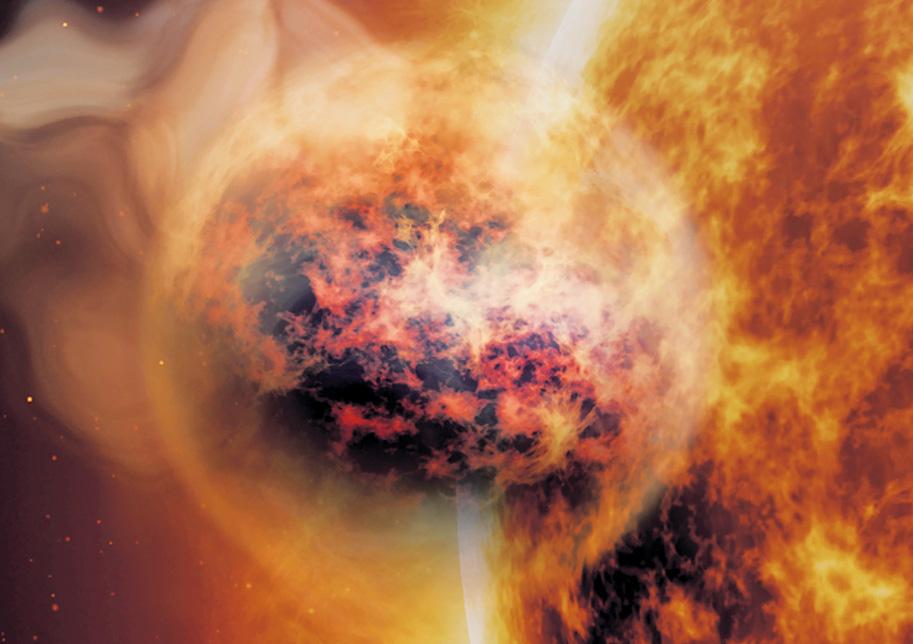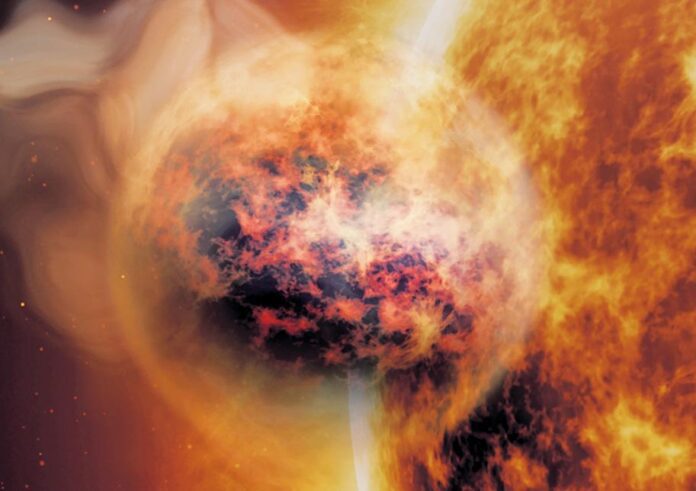A Celestial Marvel: Wasp-107b
Nasa’s James Webb Space Telescope has opened a new chapter in our exploration of the cosmos by uncovering the fascinating secrets of Wasp-107b, a distant planet residing 200 light years away in the Virgo constellation. Termed the “candy floss” planet, this celestial body has intrigued astronomers not only for its significant size but also for its ethereal nature. The groundbreaking observations made by the James Webb telescope have unveiled a world beyond our solar system that defies our conventional understanding of planets.



Peculiarities of Wasp-107b
Wasp-107b earned its nickname due to its unique combination of being both large and exceptionally light. The recent observations conducted by the James Webb telescope have illuminated the extraordinary features of this exoplanet, providing unparalleled insights into its atmosphere and environmental conditions.
Unprecedented Glimpse into Exoplanetary Atmosphere
Professor Leen Decin, the lead author of the research from the Catholic Institute (KU) Leuven, emphasizes the limitations of our knowledge about other planets, noting that our understanding is primarily grounded in Earth-based perspectives. The James Webb telescope transcends these limitations by employing advanced techniques to analyze starlight filtered through Wasp-107b’s atmosphere.
Wasp-107b’s Vast and Fluffy Nature
Wasp-107b, while similar in mass to Neptune, boasts a size nearly equivalent to Jupiter. Its vast and diffuse characteristics make it an ideal target for the James Webb telescope, allowing scientists to delve deep into its atmosphere. The “fluffiness” of Wasp-107b is a crucial factor that enables significant signals to be detected during atmospheric observations.
Chemical Composition and Atmospheric Dynamics
The latest findings, published in Nature, unravel a myriad of intriguing details about Wasp-107b. The planet’s atmosphere contains evidence of water vapor and sulphur dioxide, imparting a distinctive scent akin to burnt matches. Moreover, these observations mark the first instance of identifying the chemical composition of clouds on another planet – silicate sand clouds, to be precise.
Sand Rain and Exotic Atmospheric Processes
The atmospheric dynamics on Wasp-107b introduce a novel perspective, resembling Earth’s water cycle but with a twist. Silicate vapors rise from the scorching lower levels of the atmosphere, forming microscopic sand grains that eventually coalesce into clouds. These sand clouds, too small to be seen, undergo a mesmerizing cycle of raining back down to the lower layers, only to sublime back into vapor below a certain level.
James Webb’s Mission: Beyond Exoplanetary Weather
James Webb’s Mission: Beyond Exoplanetary Weather
The James Webb Space Telescope (JWST) stands at the forefront of astronomical innovation, poised to revolutionize our understanding of the cosmos. While its recent observations of Wasp-107b have unveiled the exotic weather and atmospheric dynamics of a distant “candy floss” planet, the telescope’s overarching mission extends far beyond merely scrutinizing exoplanetary weather patterns.
Unveiling Celestial Secrets
Unprecedented Precision in Observation
The JWST, often hailed as the successor to the Hubble Space Telescope, boasts an array of cutting-edge technologies that enable astronomers to peer deeper into space with unparalleled precision. Its advanced capabilities allow for detailed observations of celestial bodies, offering scientists a front-row seat to the intricate mechanisms governing our universe.
Analyzing Exoplanetary Atmospheres
One of the primary objectives of the JWST is the analysis of exoplanetary atmospheres. By employing sophisticated spectroscopy techniques, the telescope can dissect the light passing through a planet’s atmosphere, revealing the chemical composition and providing crucial insights into its environmental conditions. Wasp-107b serves as a prime example of the JWST’s prowess in unraveling the mysteries of distant worlds.
Beyond Exoplanetary Weather: The Search for Life
Identifying Biosignature Gases
While investigating the weather patterns of exoplanets is undeniably fascinating, the JWST’s ultimate quest extends to the search for signs of extraterrestrial life. The telescope aims to detect biosignature gases – atmospheric markers that could indicate the presence of living organisms. Identifying these gases in the atmospheres of distant planets is a tantalizing step toward answering one of humanity’s most profound questions: Are we alone in the universe?
Challenges in the Search for Life
The conditions for habitability extend beyond the mere existence of water or a temperate climate. The JWST recognizes the need to consider a multitude of factors, including atmospheric compositions, in the quest to find potentially habitable exoplanets. While Wasp-107b may not harbor life as we know it, the telescope’s detailed analysis contributes crucial data to the broader search for suitable environments beyond our solar system.
Encouraging Signs for Future Discoveries
Unveiling New Perspectives
The intricate details captured by the JWST during its examination of Wasp-107b underscore the telescope’s ability to unveil new perspectives on the diversity of exoplanetary atmospheres. As technology advances and observational techniques refine, the potential for discovering unexpected features and atmospheric phenomena on other worlds becomes increasingly promising.
Bridging the Gap in Scientific Understanding
The JWST serves as a bridge between our current scientific understanding and the myriad possibilities awaiting exploration. By studying a diverse range of exoplanets, from the massive and diffuse Wasp-107b to smaller, rocky worlds, the telescope contributes to a comprehensive catalog of celestial bodies, expanding our knowledge of the vast tapestry of the universe.
Broadening Our Imaginations
Challenging Assumptions About Habitability
The discovery of Wasp-107b’s sand rain and exotic atmospheric processes challenges conventional assumptions about habitability. As the JWST continues to unravel the mysteries of distant planets, scientists are prompted to broaden their imaginations regarding the potential forms of life that could exist beyond Earth. The quest for habitable zones extends beyond the familiar conditions found on our home planet, pushing the boundaries of what we consider suitable for life to thrive.
Inspiring Future Generations
The JWST’s mission goes beyond scientific inquiry; it inspires curiosity and captivates the imagination of people around the world. By pushing the frontiers of exoplanetary exploration, the telescope sets the stage for future generations to dream, discover, and aspire to explore the cosmos in ways that were once thought impossible.
A Universe of Surprises: The Ongoing Journey
Continuation of Cosmic Exploration
As the JWST continues its journey through the cosmos, each observation contributes to an ongoing saga of cosmic exploration. The universe, with its myriad surprises, promises a tapestry of celestial wonders waiting to be unveiled. The telescope stands as a beacon of human ingenuity, guiding us deeper into the mysteries of the cosmos and sparking a relentless curiosity to explore the unknown.
In conclusion, the James Webb Space Telescope’s mission extends beyond the confines of exoplanetary weather, reaching into the realms of potential extraterrestrial life and inspiring a new era of cosmic discovery. As we navigate the vastness of space, the JWST serves as a testament to humanity’s enduring quest for knowledge and understanding in the boundless expanse of the universe.
Broadening Our Imaginations: Life Beyond Earth
Professor Decin emphasizes the need to broaden our imaginations when contemplating life beyond Earth. The discovery of Wasp-107b, with its exotic features and unexpected atmospheric processes, challenges preconceived notions about habitability. The search for life in the universe may unfold in ways that differ vastly from what we know on Earth, prompting scientists to expand their perspectives and explore alternative pathways for the emergence of life.










